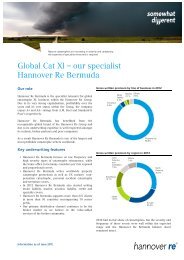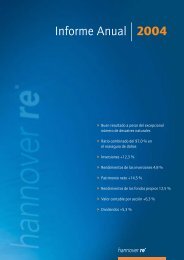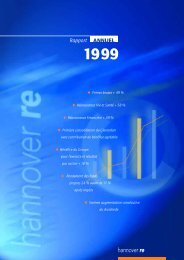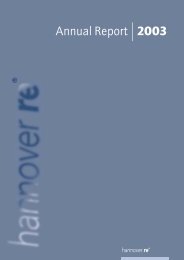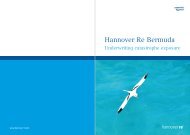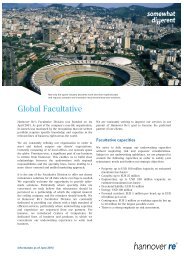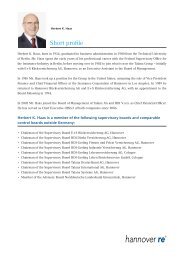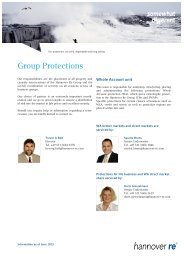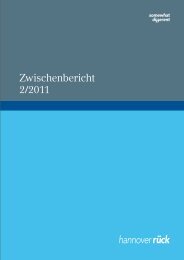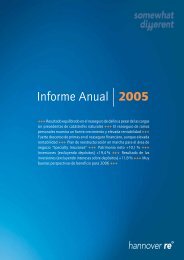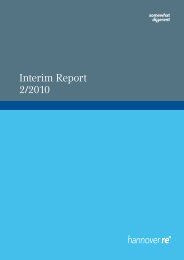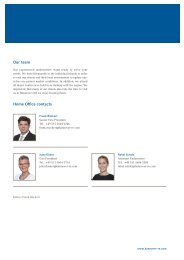Annual Report 2010 - Hannover Re
Annual Report 2010 - Hannover Re
Annual Report 2010 - Hannover Re
You also want an ePaper? Increase the reach of your titles
YUMPU automatically turns print PDFs into web optimized ePapers that Google loves.
The projections, which cover various model scenarios (“conservative<br />
assumptions” versus “best estimate”), constitute the<br />
starting point for numerous areas of application encompassing<br />
quotation, the determination of carrying values and embedded<br />
values as well as contract-specific analyses, e.g. regarding<br />
the appropriateness of the recognised reinsurance liabilities<br />
(“liability adequacy test”). In this context we would refer the<br />
reader to our comments on technical assets and provisions in<br />
Section 3.2 “Summary of major accounting policies” and on<br />
the liability adequacy tests in Section 5.7 “Technical provisions”.<br />
In determining the carrying values for certain financial assets<br />
it is sometimes necessary to make assumptions in order to<br />
calculate fair values. In this regard we would refer the reader<br />
to our remarks in Section 3.2 “Summary of major accounting<br />
policies” concerning financial assets at fair value through profit<br />
or loss and securities held as available for sale. Assumptions<br />
concerning the appropriate applicability criteria are necessary<br />
when determining the need for impairments on non-monetary<br />
financial assets held as available for sale. In this regard we<br />
would again refer the reader to our explanatory remarks in<br />
Section 3.2 “Summary of major accounting policies”.<br />
<strong>Hannover</strong> <strong>Re</strong> has refined the calculation logic for the fair values<br />
of derivatives in connection with Modified Coinsurance/<br />
Coinsurance Funds Withheld reinsurance treaties. This represents<br />
a change in an accounting estimate, which pursuant to<br />
IAS 8 “Accounting Policies, Changes in Accounting Estimates<br />
and Errors” was performed in the year under review without<br />
adjustment of the comparative figures for previous years. For<br />
further details please see the remarks on derivative financial<br />
instruments in Section 7.1 “Derivative financial instruments”.<br />
4. Consolidation<br />
4.1 Consolidation principles<br />
Capital consolidation<br />
The capital consolidation complies with the requirements of<br />
IAS 27 “Consolidated and Separate Financial Statements”.<br />
Subsidiaries are consolidated as soon as <strong>Hannover</strong> <strong>Re</strong> acquires<br />
a majority voting interest or de facto controlling influence.<br />
The same is true of special purpose entities, the consolidation<br />
of which is discussed separately below.<br />
Only subsidiaries which are of minor importance – both individually<br />
and in their entirety – for the net assets, financial position<br />
and results of operations of the <strong>Hannover</strong> <strong>Re</strong> Group are<br />
exempted from consolidation. <strong>Hannover</strong> <strong>Re</strong> assesses whether<br />
a subsidiary is of minor importance on the basis of the company‘s<br />
total assets and net income relative to the corresponding<br />
values for the Group as a whole on average over the last<br />
three years. For this reason 26 (18) companies at home and<br />
abroad, the business object of which is primarily the rendering<br />
of services for reinsurance companies within the Group, were<br />
not consolidated in the year under review.<br />
The capital consolidation is based on the revaluation method.<br />
In the context of the “purchase accounting” method the acquisition<br />
costs of the parent company are netted with the proportionate<br />
shareholders‘ equity of the subsidiary at the time when<br />
it is first included in the consolidated financial statement after<br />
the revaluation of all assets and liabilities. After recognition of<br />
all acquired intangible assets that in accordance with IFRS 3<br />
“Business Combinations” are to be accounted for separately<br />
from goodwill, the difference between the revalued shareholders‘<br />
equity of the subsidiary and the purchase price is recognised<br />
as goodwill. Under IFRS 3 scheduled amortisation is not<br />
taken on goodwill. Instead, impairment is taken where necessary<br />
on the basis of annual impairment tests. Immaterial and<br />
negative goodwill are recognised in the statement of income<br />
in the year of their occurrence.<br />
Minority interests in shareholders’ equity are reported separately<br />
within Group shareholders’ equity in accordance with<br />
IAS 1 “Presentation of Financial Statements”. The minority<br />
interest in profit or loss, which forms part of net income and<br />
is shown separately after net income as a “thereof” note,<br />
amounted to EUR 82.0 million (EUR 40.3 million) in the year<br />
under review.<br />
Notes<br />
<strong>Hannover</strong> <strong>Re</strong> Group annual report <strong>2010</strong><br />
4.1 Consolidation principles Notes<br />
123



